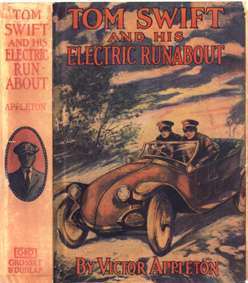 Note: some of the
language, references & attitudes, while acceptable at the time they were
written, are not Politically Correct, today.
Note: some of the
language, references & attitudes, while acceptable at the time they were
written, are not Politically Correct, today.Tom Swift and His Electric Runabout
or, The Speediest Car on the Road
By Victor Appleton Book #5 ©1910
Review by JP Karenko, May 2005
Full-color image from the collection of James D. Keeline
White Quad, Brown Quad and Duotone images from the collection of Mark Snyder
 Note: some of the
language, references & attitudes, while acceptable at the time they were
written, are not Politically Correct, today.
Note: some of the
language, references & attitudes, while acceptable at the time they were
written, are not Politically Correct, today.
Summary: No official summary was ever provided with any of the old Tom Swift books. However, without giving too much away, the plot can be summed up as follows:
The book opens with Barton Swift & son discussing a trip to Long Island, NY, to enter a race for electric automobiles. Tom has been working on a new rechargeable battery that he feels would be ideal for use in a racing automobile, due to its' endurance and quick-charge capabilities. The discussion is interrupted by a series of violent noises coming from the roof of the house. Mr. Damon has added airships to the list of vehicles he has crashed while piloting, by tangling the Red Cloud's running gear (See Book #3) in the house's chimney.
Tom has another run-in with Andy Foger, who now is driving a new 4-speed auto. This further hardens his resolve to build the "Speediest Car on the Road," one with a 100mph top speed. The Fogers, (father and son) have it in for the Swift family, and now plan to ruin them financially by breaking the bank where Tom & Barton keep their funds. The FDIC had not yet been invented, and running out of cash could cause a bank to fail, when depositors lost faith in the institution and withdrew their deposits.
Not willing to wait for financial ruin to set in, Andy and his cohorts Sam & Pete, join a gang called The Deep Forest Throng, and kidnap Tom. Tar & feathers as well as some lumps, are in Our Hero's future. Tom also manages to survive near-electrocution, when an old nemesis sabotages his new machine. Poor Tom, who is now a bit tattered and crispy around the edges, vows to stay home and out of trouble, for a while. (Yeah, right!)
A solution to the bank's problems, and mastering the rigors of racing 500 miles in a prototype vehicle are all told in the remainder of the story.
This book is available online. See: Tom Swift and His Electric Runabout
![]()
Cast of Characters (More or less in order of appearance)
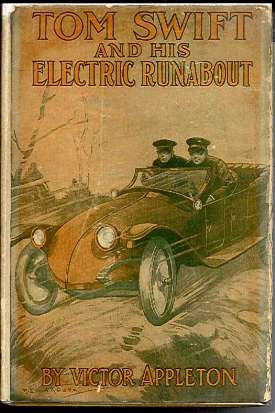 Barton
Swift-Widower. Wealthy and conservative. Inventor, master machinist and
holder of numerous patents. In this episode, described as "aged" and "nervous."
In this tome, he becomes a director on the board of Shopton's (First) National
Bank.
Barton
Swift-Widower. Wealthy and conservative. Inventor, master machinist and
holder of numerous patents. In this episode, described as "aged" and "nervous."
In this tome, he becomes a director on the board of Shopton's (First) National
Bank.
Tom Swift-Intrepid inventor & mechanic. Plucky, lively, resourceful, brave and clever. Home-schooled at a college level by his father, Barton Swift. Athlete and hunter. Familiar with how to stalk game and firearms. Loves all things mechanical. Is a decent cook, too.
John Sharp-Professional balloonist and trapeze artist. Rescued by Tom when his hot-air balloon gets a bit too hot and burns. Deputy Sheriff as a sideline. Co-designer with Tom, of the Airship, Red Cloud. Tall, thin and ëdark' of complexion. "In residence" with the Swift family, has become sort of hands and feet for Tom's father.
Mr. Wakefield Damon-Elderly & eccentric adventurer whose main purpose in life seems to be blessing everybody and everything near his person. In this episode, he has graduated from crashing motor-cycles & automobiles to crashing airships. He parks the Red Cloud on the roof of Tom's house. This damages both it and the house's chimney. Meanwhile, he blesses everything in close proximity. Later, he becomes a director on the board of Shopton National Bank.
Mrs. Baggert-Housekeeper. Kindly, and "loves Tom like a son." Employed by the Swift family since the time Tom's mother died. She is short of stature and has to stand on a soap box to kiss Tom goodbye on one of his voyages. Excitable, she seems to expect fatalities after any mishap involving Tom's inventions. The airship on the roof causes her much worry.
Garrett Jackson -- Aged (65+ years old) "engineer" who is more a handyman/machinist and watchman type than engineer. Resides on Swift estate.
Andy Foger-Red haired, squinty-eyed bully, who makes great trouble for Tom. "Poor little rich kid," son of wealthy family, born with a chip on his shoulder. Reckless, blustery and angry. Showoff. "Has money, and not much else." Lately has upped ante to kidnapping Tom. (See Deep Forest Throng, below.)
Sam Snedecker-Willing cohort of Andy Foger. No description given except for "large ears.". Could be an OK guy if he were to stop associating with Andy Foger, but seems to be going downhill, character-wise. (See Deep Forest Throng, below.)
Pete Bailey-Cohort and willing minion of Andy Foger. No description given. Generic bad guy. (See Deep Forest Throng, below.)
Mr. Foger -- NFN given. Starts a new bank in town ( Two "national" banks in a "village." Hm!) He tries to ruin Swifts financially by causing a "run" on their (1st national) bank.
Ned Newton-Chum & companion of Tom, currently employed in Shopton 1st National Bank as a newly promoted assistant cashier.
Miss Mary Nestor --Budding love interest who lives in neighboring town of Mansburg. Described as a "fair young woman with flashing brown eyes." Blushes easily, especially around Tom.
Captain Alden Weston -- Soft-spoken and mild mannered sea captain, world traveler and soldier of fortune. Hired by Swifts to navigate their sub in book #3. Described as smooth of face and with merry blue eyes. Main characteristic is an apologetic, self-effacing language. Ends nearly every sentence with "if you don't mind" or "if I may say so" or variations of same. In this tome, plays no direct role, but is said to have invested his share of the submarine gold promoting "a South American revolution."
The Deep Forest Throng -- Gang of ten or twelve bumbling ne're-do-wells. Black hooded "secret society" that isn't all that secret, since most are ignorant enough to use each other's names during hooded nefarious activities. They waylay and kidnap Tom with intent to tar & feather him for the crime of "being uppity." Members include Cecil Hedden, the leader, Jack Reynolds, Sid Holton, Andy Foger, Sam Snedecker, Pete Bailey, and unnamed others.
Eradicate Andrew Jackson Abraham Lincoln Sampson, A.K.A. Rad-Aged stereotypical Negro journeyman jack-of-all-trades. "Eradicates dirt." Lately, acts as watchman to keep intruders away from Swift property. Armed with a bucket of whitewash.. Heavy deep-south accent and Uncle Remus attitude. Caretaker of Boomerang, a cantankerous aged mule.
Mr. Mason -- NFN or description given. Seems to know Tom, but has not been previously introduced in other stories. (See errata.)
Addison Berg -- Ex-representative of Bentley & Eagert, a submarine building firm. Industrial spy and all-around bad guy. Sabotages Tom's motor experiment causing Tom to be near-electrocuted. Trying to steal the secrets of Tom's new battery cell. Cohort of Andy Foger's father at new bank in town.
Dr. Whiteside -- NFN or description given. Town physician, renders aid to Tom when he is shocked during a botched experiment with the runabout motor. Offices in his home.
Miss Whiteside -- NFN or description given, except "pretty." Daughter of town doctor, nurses Tom back to health.
Paul Layton -- No description given. Auto enthusiast from nearby Netherton, who races Tom with a 6 cylinder, 4-speed roadster at 60mph on rutted dirt roads.
Isaac Pendergast-President of Shopton 1st National Bank. Aged, pompous & blustery. Ned Newton's boss. In this tome, not so blustery, as his institution is threatened with failing.
Mr Chase -- NFN or description given. Official of Clayton National Bank. Acquaintance of Mr. Damon.
Gang of Masked Armed Highwaymen -- Recently escaped from jail. Possibly in collusion with Addison Berg or Mr. Foger, since they know about the cash transfer, timing and route Tom & Mr. Damon are taking..
Jethro Lyon -- No description given. Farmer from Salinas Township. Aids Tom & Mr. Damon during attempted robbery.
Ade & Burt Lyon -- No descriptions given. Sons of Jethro. Aid Tom & Mr. Damon during attempted robbery.
Bub Armstrong -- No description given. Nephew of Jethro Lyon. Aids Tom & Mr. Damon during attempted robbery. Expert with a bullwhip. Able to simulate fusillade of gunshots.
Miss Mary Nestor -- Seen in an "immaculate Summer gown" and gloves. Love interest of Our Hero. Journeys to Long Island to see Tom race his Runabout. (Is this devotion, or what???)
![]()
Major Inventions
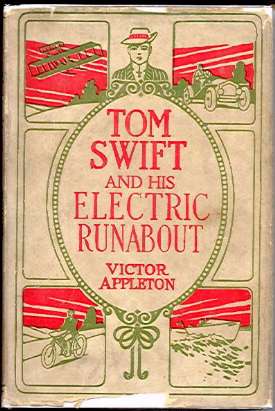 Tom Swift finally invents something major
in this book. Several somethings, actually. First is a new technology wet-cell
rechargeable battery. This is based on Nickle Oxide, Ferric Oxide and Steel
tubes with a Lithium Hydrate (See errata) electrolyte. This cell can be
recharged in half the time as the usual wet cell, and has a quantum increase in
energy density.
Tom Swift finally invents something major
in this book. Several somethings, actually. First is a new technology wet-cell
rechargeable battery. This is based on Nickle Oxide, Ferric Oxide and Steel
tubes with a Lithium Hydrate (See errata) electrolyte. This cell can be
recharged in half the time as the usual wet cell, and has a quantum increase in
energy density.
Electric vehicles of the day, while not unusual, had poor performance and desperately needed "improving." Tom sets about to design a 4-seat runabout that was intended to attract the attention of a major manufacturer. Innovations for this vehicle include: Mid-body running gear consisting of 2-speed geared twin electric motors driving the rear wheels through motorcycle-type chains. Battery compartments were distributed front, rear and midline, presumably for best balance. A 4th "reserve" battery was carried for emergencies. Two spare wheels, a tire repair kit and tools were kept under the rear seat. Body construction was steel, pointed and sloped (aerodynamically shaped, at least for that day ) and included a raise-able steel wind screen with celluloid window. These streamlining items, plus a tonneau cover and leather side curtains all contributed to low drag for increased top speed. In addition to the usual oil headlights, a powerful electric spotlight could be used for nighttime travel. The appearance of the vehicle was enhanced by a distinctive purple paint job, protected with multiple coats of varnish. Battery charging could be accomplished from either a regular "charging station," or hookup to a trolley line or street lamp. No mention if overall weight was given, but this baby must have been a low-rider, and weighed a ton. (Or more!)
The initial intended range was to be 300-400 miles with 2 passengers, and a top speed on smooth road of 100mph. This kind of performance would be impressive, even today, except for the lack of creature comforts, like heat, air, power steering and satellite radio...
![]()
Commentary on Society, Attitudes, Environment & Errata
It's amazing how much society and technology have changed in 95 years. Reading the old Tom Swift Sr. series has really given me an appreciation of all the modern gadgets that I've come to take for granted, (like my Olds Alero.) It also gives me an appreciation as to how much society has changed, too. I wonder what people will be taking for granted 100 years from now, and what they will think of our times? I believe Robert Heinlein put it best when he described this era as "The Crazy Years."
Attitudes and Prejudices- Language usage is interesting at times. A reference was made to a "catty" on p31, as some kind of lever. An extensive Google search turned up only 2 references: Most common was the usual reference to nasty or coy attitude.
UPDATE: The "catty" mentioned in the book has been located! Here is the definition from the Oxford English Dictionary:
cat (___), n.1 Forms: 1 catte, catt, 2‚7 catt, 4‚6 catte, (3‚7 kat, 6 katte), 1‚ cat.
10.
A term used in various games.
a.
A small piece of wood tapering at each end, used in the game of tip-cat,
etc.; it is hit at one end by the
cat-stick,
and made to spring from the ground, and then driven away by a side stroke.
1598
Florio,
Lippo,
a trap or cat, such as children play at.
a1627
Middleton Wom.
beware Wom. i. ii,
Prithee,
lay up my cat and cat-stick safe.
a1652
Brome New Acad.
iv. i. Wks. 1873 II. 66
All my
storehouse of tops, gigs, balls, cat and catsticks.
1801
Strutt Sports and
Past. 101 (N.)
The cat is
about six inches in length, and an inch and a half or two inches in
diameter, and diminished from the middle to both ends, in the manner of a
double cone.
b.
The game itself; tip-cat.
1626
in Windsor & Eton
Gaz. (1886) 6 Mar. 4/5
Playing at
Catt in the Parke medow.
1653
J. Taylor (Water P.)
Journ.
Wales
(1859) 26
The lawful
and laudable games of trapp, catt, stool-ball, racket, etc.
1801
Strutt Sports &
Past. ii. iii. 101.
1885
J. Brown Bunyan
61
He was one
Sunday in the midst of a game of cat.
Some pictures of a "catty" have been located as well. The following images are taken from the Laurel & Hardy film March of the Wooden Soldiers and are copyright (c) 1991 by MGM Studios.
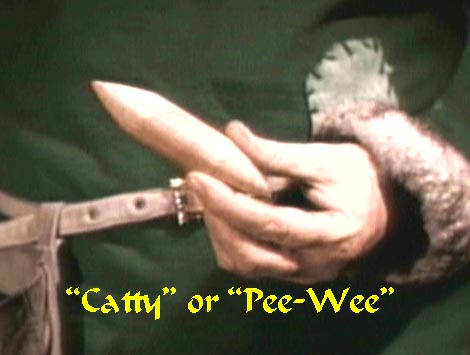
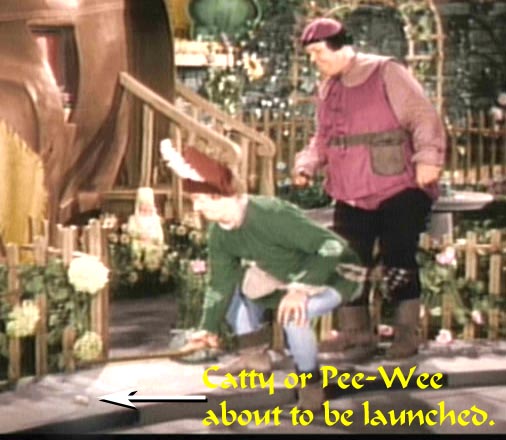
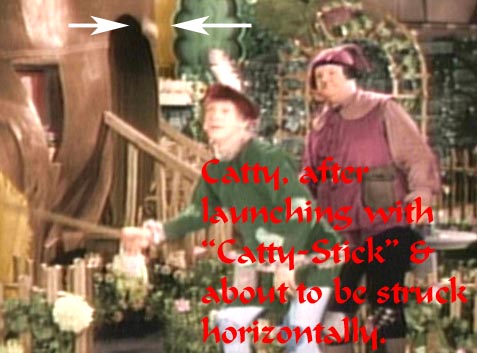
The other was an oriental measure used in commerce, with a mass of around 500grams. A reference to "scaring Mrs. Zenoby's cat," turned up exactly nothing. Shoes had buttons, and stoves (presumably cast-iron) required regular maintenance with a "blacking" polish. I presume this was to prevent or perhaps, conceal rust.
Captain Weston, as a US citizen, seems to be able to finance a South American revolution. Mr. Damon is ordered to drink lemon juice by his doctor, to aid in healing his ailing liver.
The media is already up to its' tricks of misrepresenting and exaggerating "facts." Tom's car is reported to have a top speed of 500mph, and to travel without touching the ground.
Speed laws are apparently only enforced inside towns and villages. Considering most roads are dirt, one-lane with ditches on both sides and have soft spots and ruts, this is probably adequate.
Segregation is commonplace and "normal" with Rad going to "a colored dance." Reference to "darkies" was descriptive, rather than a "racial epithet," as we call it, today.
At least some folks appeared to be incredibly naÔve in this story. After being accosted by armed and masked men, who met ALL of today's legal requirements for committing armed robbery, Tom & Mr. Damon speculate as to whether the death threats, demands for the cash and the display of firearms was "just to delay or frighten them." <Duh!>
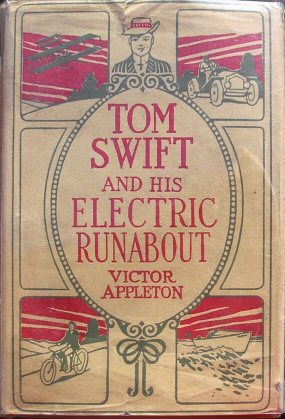 Errata- Typos were
few and far between. On p48 a reference was made to "pump it up out lamps." The
(out) may have been an error, or the demountable headlights on Mr. Damon's car
may have been a Coleman lantern type and really did need periodic pumping. The
reference in the text seemed to relate to a tire pump. On p178, "I don't draw
out" probably was intended to be "won't," referencing a bank deposit.
Errata- Typos were
few and far between. On p48 a reference was made to "pump it up out lamps." The
(out) may have been an error, or the demountable headlights on Mr. Damon's car
may have been a Coleman lantern type and really did need periodic pumping. The
reference in the text seemed to relate to a tire pump. On p178, "I don't draw
out" probably was intended to be "won't," referencing a bank deposit.
Tom's father is invited to ride on the first test of the runabout, and declines. However, he is later in the ride, quoted as teasing Tom, even though not present.
Tom gets sufficiently "lit up" by some sabotaged wires, to lose consciousness and "need his heart action adjusted" by the town doctor. Since as little as 24 DC volts can be lethal, one wonders, how he manages to survive repeated jolts of current. His shock was described as "from hand to hand," the worst kind. If his heart action was disrupted enough for him to go unconscious, I suspect that in any real world, by the time he was taken to the doctor, he'd be dead.
Tom's runabout is described as "the speediest car on the road," but the robbers who waylay him & Mr. Damon, seem to be able to move around faster, getting informed of the cash transfer, and organizing not one, but two ambushes, 20 miles apart. Go figure.
Engineering and Science, Fact vs. Fantasy- In this volume, it is apparent that the knowledge of the author(s) at least as to what makes a "good" electric vehicle is at least adequate. The runabout features and specifications would be impressive, even today.
Designing this beast in 3 to 4 days and building it from the ground up in 3 months, working alone, is however, fantasy. Insulation on wiring was either very poor or altogether missing. Crossed wires and repeated exposure to current resulted in re-volting developments, and many fireworks, story-wise.
Tom's battery chemistry sounds fishy. Thomas Edison developed a Lithium/Iron battery about that time (1906) but it was a primary (non-rechargeable) cell. Lithium ion technology was unheard-of and when it finally was tried, 60 years after this story, the explosion hazards of overcharging limited its applications, at least for a while. When asked, my local battery expert, Dr. Keith Shaw, stated simply, "the chemistry wouldn't work."
As to chemistry, the Lithium Hydrate that Tom threw in a fire to escape kidnappers would burn (if at all) with a reddish-to-white flame, not blue, and would hardly explode, as was described in the text. It was also nothing to carry in a pocket, as Tom did, since it is corrosive. Lithium Hydride liberates Hydrogen, but must be wet to do so. As to "rumbling" gunpowder, at least in small quantities, even black powder makes a "poof" or a sizzle, unless confined.
Tom's machine suffers from repeated tire troubles. The 30 inch diameter tires of the day, were tube-type with no tread to speak of. Tread (for rear wheels only) was not introduced for another 10 years, according to data from http://www.modelt.org/RTires.html
Running a smooth, un-reinforced tubed tire at 80 or 100mph would be suicidal, especially on rutted dirt roads. What the authors apparently did not realize was that "racing" tires, capable of even faster speeds, were solid. If a tire let go, the result was usually fatal, sometimes to anyone even close to the event. Chunks flew everywhere. Based on this, a good follow-up story would be Tom Swift and His Steel-Belted Radial Tires.
Tom suffers two blowouts in 500 miles, and is forced to pit stop to change wheels. His pit stop took 5 minutes (Dale Earnhart must be rolling in his grave) and during that time, his competition got a æ lap lead on him. Since they were on a 5 mile oval, this means that average race speeds were a blistering 45mph, nothing near the top speed of 100, claimed by Tom for the runabout, and very slow, compared to (Stanley) steamer car races of that era, which exceeded 100mph, consistently. Authors may have also been mathematically challenged.
Geography- We find that Ned Newton's home is about a mile beyond the far village limit of Shopton. The local high spot (altitude-wise) is something called "Berk's Hill," and was considered a driving hazard for local vehicles. Mansburg, home of Mary Nestor, is described as near the head of the lake (Carlopa.) In other volumes, the lake is described as much larger, with Mansburg being close to Shopton, and Shopton midway up the East shore of the lake.. Waterfield (where the authors have finally decided to consistently place Mr. Damon's home) is beyond Mansburg, but close enough for a casual jaunt via motor cycle, horse, carriage or auto, all of which Mr. Damon has managed to lose control over. There is a new village (Netherton) which is mentioned, but with no direction or distance given. The city of Clayton is said to be 40 miles distant, but in an unspecified direction, except to say that the road there was hilly, with cliffs and in mostly poor shape. Bridges over rivers and streams were in many cases described as "frail" and could not be crossed at speed. On the Jersey shore, Tom's HQ (the submarine cottage) was an "easy run" from Havenford, LI, the location of the Tourng Club of America's new race track. I had placed it further south, near Atlantic City, (Atlantis,) in the book.
JP Karenko 5/8/05
![]()
Tom Swift and His Submarine Boat | Tom Swift and His Wireless Message | Index